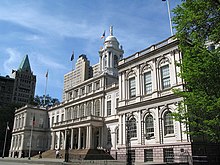City Hall (New York City)
The City Hall in New York City is the oldest city hall in the United States still in use and is located on Broadway at the corner of Park Row Street at City Hall Park in Lower Manhattan . The building was built from 1803 to 1812 and is one of the historic landmarks of the city of New York and the United States. The town hall is the seat of the council and the mayor .
history

The city's first town hall was built on Pearl Street in the 17th century by the Dutch then resident there . The city's second City Hall was placed on Wall Street and was named the Federal Building after the American Revolutionary War (1775–1783) when New York City became the first capital of the new state . After Albany was elected capital of New York State in 1797 , plans arose for a new town hall, but these were postponed indefinitely due to the cost of the war.
In 1802, the town hosted a competition for a new town hall, by John McComb Jr. was recovered. He received US $ 350 for his design, according to which the town hall was built for around US $ 350,000. Since then, the building has been used as New York City's City Hall.
The construction of the new town hall was delayed due to an objection from the town council that the first draft was too dissolute. In response, McComb and Mangin reduced the size of the building, using brown sandstone at the rear of the building to reduce costs (the brown sandstone, compounded with the original, degraded Massachusetts marble facade , was replaced with Alabama limestone from 1954 to 1956 ). Industrial disputes and an outbreak of yellow fever slowed construction of the building further, which meant that the building was not inaugurated until 1811. The official opening took place in 1812.
The famous Governor's Room has been used as a museum and reception hall for celebrations related to city and national history since it was completed in 1816.
architecture
The building was built in a mixed style of French Renaissance (exterior facade) and Georgian architecture (interior design). In December 1960, City Hall was declared a National Historic Landmark , and in 1966 it was added to the National Register of Historic Places .
Surroundings
City Hall is located in what is known as the Civic Center , an area of Manhattan dominated by municipal, state, and state administration buildings. Well-known buildings near City Hall include St. Paul's Chapel, St. Peters Church, the Woolworth Building , Tweed Courthouse, the Manhattan Municipal Building , the Park Row Building , One Police Plaza, and the Brooklyn Bridge . Rathauspark is only three blocks from the site of the former World Trade Center . The City Hall underground station, which was decommissioned in 1945, is located directly under Rathausplatz . Designed by Rafael Guastavino and opened in 1904 as the parade and southern terminus of the first New York subway line , it is considered to be one of the most beautiful stops on the New York subway . Today there are two stops a little further away that have City Hall in their name: Brooklyn Bridge - City Hall on the corner of Park Row and Center Street (for lines 4, 5, 6) and City Hall on the corner of Murray Street and Broadway ( for trains on lines N, R, W).
Individual evidence
- ^ A b New York City Government: A brief history of city hall. Retrieved October 16, 2015 .
- ↑ Listing of National Historic Landmarks by State: New York. National Park Service , accessed August 19, 2019.
- ^ NRHP, National Park Service: National Register Information System. Retrieved October 16, 2015 .
Web links
Coordinates: 40 ° 42 ′ 45.7 " N , 74 ° 0 ′ 21.2" W.

